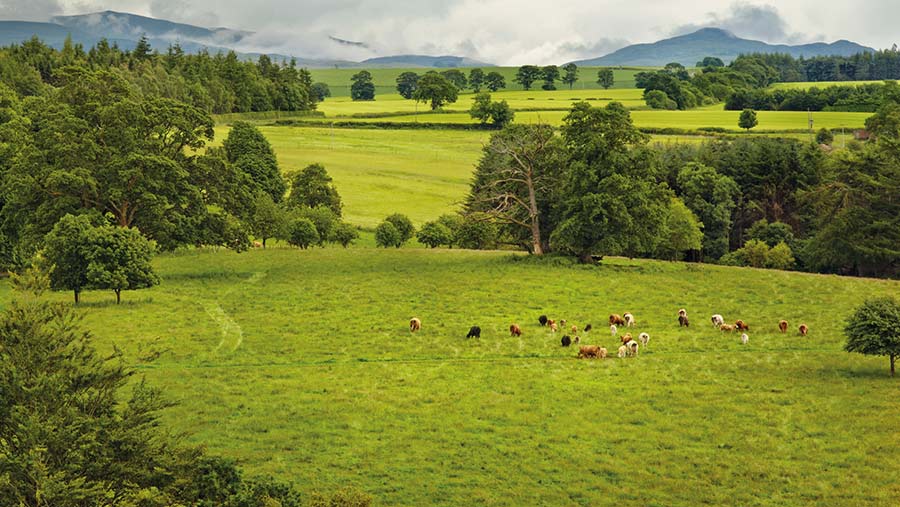Forestry and natural capital drive huge Scottish land demand
 © AdobeStock/Nataliya-Hora
© AdobeStock/Nataliya-Hora Buyers interested in commercial forestry, natural capital and carbon sequestration are behind the recent increase in land values in Scotland, according to a new report.
The Scottish Land Commission’s Rural Land Market Insights Report has drawn on published market information and interviews with sector experts to provide a current picture of landowner, buyer and seller motivations to help understand what is happening in the market and why.
It was compiled by Scotland’s Rural College in partnership with land agents Savills and Strutt & Parker, with support from the Royal Institution of Chartered Surveyors.
See also: How future land use change will affect UK farmers
The report shows the Scottish rural land market is characterised by exceptionally high demand and continued low supply, resulting in rising values.
One factor is investors looking for a safe haven in a turbulent global economy and betting on future carbon values rising.
The increase in off-market sales risks excluding certain buyers, raising questions about market transparency, and potentially reinforcing Scotland’s existing pattern of concentrated land ownership, the report suggests.
Strong growth in land values is expected to continue due to low supply and extreme demand, high levels of private wealth and corporate interests seeking land, the long-term policy on climate change, and increasing pressure on global timber markets and food supply chains.
Farmland
Being able to establish forestry on land is a significant driver of demand due to high timber prices, competitive forestry grants and carbon offset markets.
However, investment in forestry and natural capital is less influential in the country’s highly productive agricultural regions.
During the past five years, 40% of farms in the UK were purchased by non-farming buyers, according to the report.
Scottish farmland values rose 31% to £5,920/acre in 2021 (UK as a whole: up 6%), due to its long-term investment potential increasing demand.
Estates
A low number of estates being sold combined with high levels of demand has resulted in record increases in prices paid.
Opportunities in natural capital and carbon offsetting have become important drivers for estate buyers.
Total purchases in 2021 were up 119% on 2020 to £247m, with 64% of all successful estate sales taking place privately (up from 33% in 2020).
About 50% of sales went to corporate bodies, investment funds or charitable trusts, while one-third of estates were sold to overseas buyers.
Forestry land
In 2021, Scotland provided 76% of the UK commercial forestry land market and accounted for 62% of plantable land sales, with values increasing 54% on the previous year to about £4,000/acre.
There is an increasing shift towards acquiring better-quality farmland for forestry, says the report.
Protecting community
Hamish Trench, chief executive of the Scottish Land Commission, said the research emphasised that while the amount of land coming to the market has remained largely the same over recent years, demand from different buyer types has increased significantly, raising prices.
“The way the land market functions is important to Scotland’s ambitions such as net zero, nature restoration, repopulation, and community empowerment,” he said.
“Being able to participate in the market shapes not just who owns Scotland’s land, but who is able to make decisions and who benefits from land and its economic, social and environmental value.”
The report highlights a complex set of influences at work, with implications for the diversity and accountability of land ownership, community participation in the market, land use decision making and market transparency, he said.
“There is no simple answer – shaping the market in the public interest will require a careful and joined-up approach in policy, as well as responsible practice on the ground,” said Mr Trench.
Evidence is critical
Sarah-Jane Laing, chief executive of Scottish Land & Estates, said: “What is of paramount importance is that the best use is made of land for social, environmental and economic benefit.
“That includes forestry, farming, renewable energy, housing, peatland restoration, tourism and leisure.
“It is unsurprising that potential buyers are responding to clear government signals to plant more trees and sequester more carbon as part of a global effort to tackle climate change.
“However, it is clear that about half of buyers are acquiring estates and land for other reasons.
“Our members supported this research and welcome the production of data on the land market. The more reliable evidence we have, the better.
“It is critical that any new policy or regulations are based on sound evidence rather than perception.”
